Welcome to a journey through the enchanting world of French Gothic architecture, as we delve into the captivating elements found in the magnificent Orvieto Cathedral. Prepare to be mesmerized by the intricate details, soaring arches, and ethereal beauty that define this marvel of architecture. In this article, we will explore the key characteristics of French Gothic design and how they manifest in the Orvieto Cathedral, shedding light on the profound influence of this architectural style on the Italian peninsula. Get ready to be transported to a bygone era, where craftsmanship and spirituality intertwine to create a truly awe-inspiring masterpiece.
Orvieto Cathedral stands as a remarkable example of Gothic architecture, captivating visitors with its grandeur and intricate details. Located in the city of Orvieto, Italy, the cathedral is a testament to the skill and craftsmanship of the medieval builders. Its imposing facade, adorned with sculptures and reliefs, immediately commands attention and sets the tone for the awe-inspiring interior that awaits.
The design of Orvieto Cathedral bears a strong influence from the French Gothic style, which was prevalent during the construction period in the 14th century. The pointed arches, ribbed vaults, and soaring verticality characteristic of French Gothic architecture are all prominently featured in the cathedral's design. This influence not only reflects the admiration for French architectural trends at the time but also contributes to the cathedral's overall sense of grandeur and elegance.
Orvieto Cathedral is renowned for its exquisite sculptures and decorations that adorn both the exterior and interior of the building. Intricately carved stone statues, depicting biblical figures and scenes, can be found throughout the cathedral, showcasing the skill of the medieval sculptors. Elaborate frescoes, vibrant mosaics, and detailed reliefs further enhance the visual splendor of the cathedral, creating a captivating atmosphere for visitors to explore and admire.
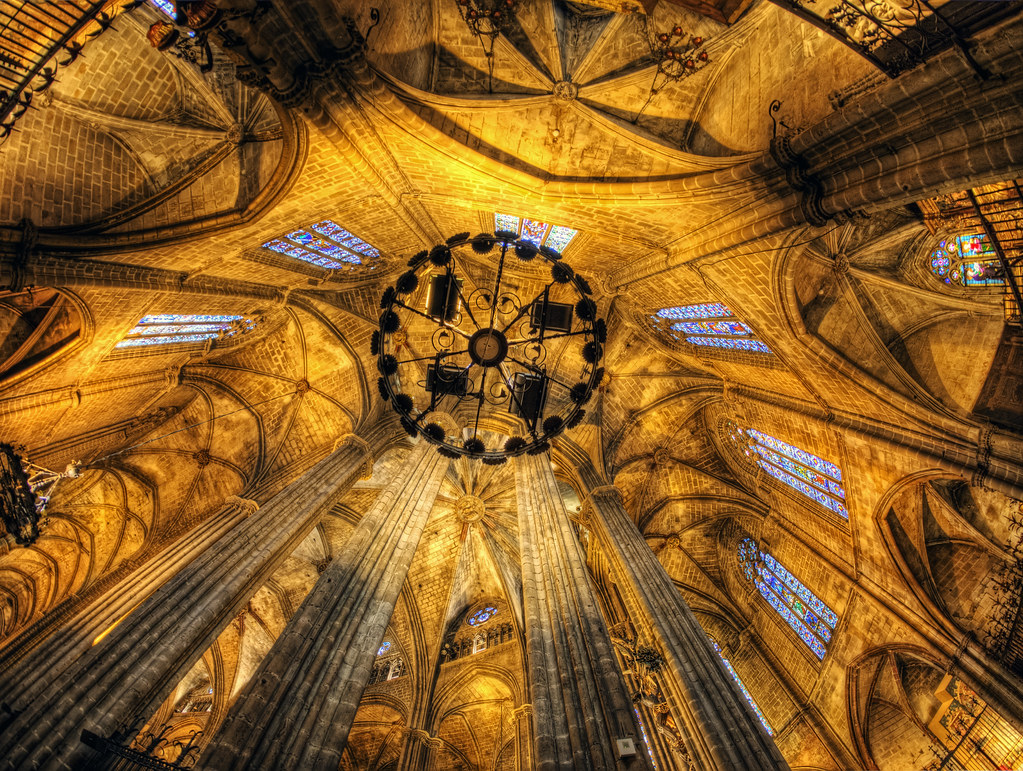
Orvieto Cathedral, located in the Italian town of Orvieto, is a magnificent example of Gothic architecture. Its construction began in 1290 and took several centuries to complete. The cathedral is known for its intricate details, soaring spires, and stunning stained glass windows.
Flying buttresses play a crucial role in the structural design of Orvieto Cathedral. These external supports, built in a distinct arch shape, help to distribute the weight of the cathedral's walls and roof, allowing for the construction of large, open spaces and soaring ceilings. The flying buttresses also add a sense of elegance and grandeur to the cathedral's exterior.
The stained glass windows of Orvieto Cathedral are a true testament to the artistry of the French Gothic style. These windows, made up of intricately designed and vibrant colored glass, depict biblical scenes and religious figures. The play of light through the stained glass creates a mesmerizing effect, adding to the spiritual atmosphere of the cathedral.
The bell tower of Orvieto Cathedral is a striking example of French Gothic verticality. Rising high above the cathedral, the tower is adorned with intricate sculptures and decorative elements. Its slender form and pointed spire contribute to the overall verticality of the cathedral's design, creating a sense of awe and majesty.
The iconography found within Orvieto Cathedral holds significant religious and historical symbolism. The intricate frescoes and sculptures depict biblical narratives, saints, and important historical events. Each element has a deeper meaning, conveying religious teachings and commemorating key moments in the history of the cathedral and the city of Orvieto.
Light plays a crucial role in highlighting the magnificent Gothic architecture of Orvieto Cathedral. The large stained glass windows allow natural light to filter through, creating a mesmerizing interplay of colors and illuminating the interior space. The strategic placement of windows and the use of light enhance the verticality and intricate details of the cathedral, captivating visitors with a sense of awe and spirituality.
The construction of Orvieto Cathedral showcases impressive stone masonry and vaulting techniques. Skilled craftsmen meticulously carved and assembled the stone blocks, creating intricate decorative elements and sturdy structural components. The use of ribbed vaults and pointed arches not only allowed for greater height and stability but also added a sense of elegance and grandeur to the cathedral's interior.
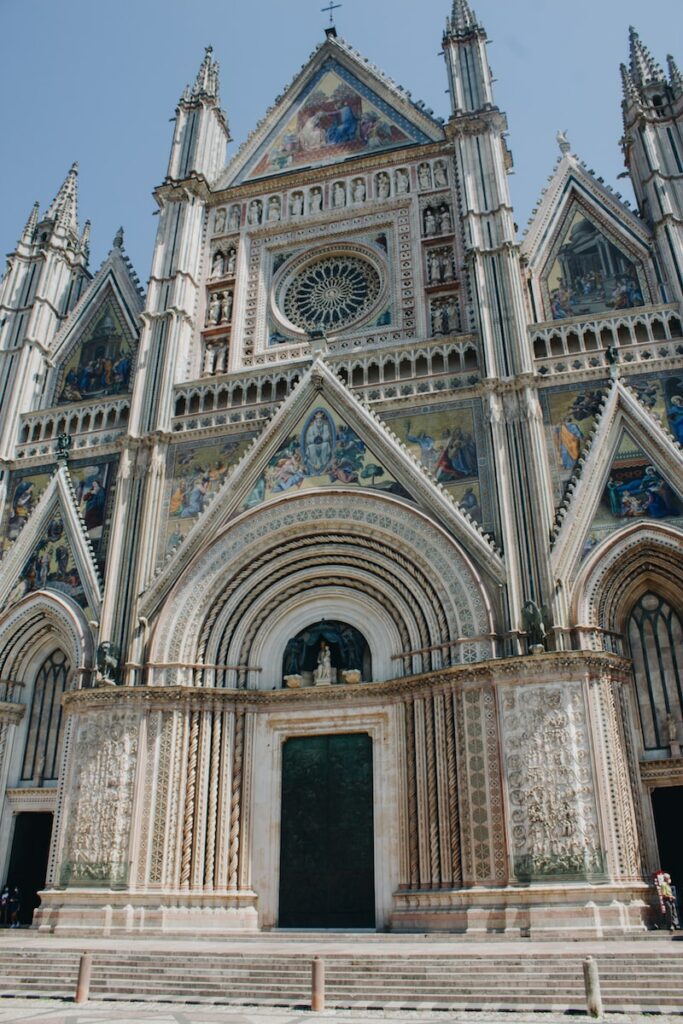
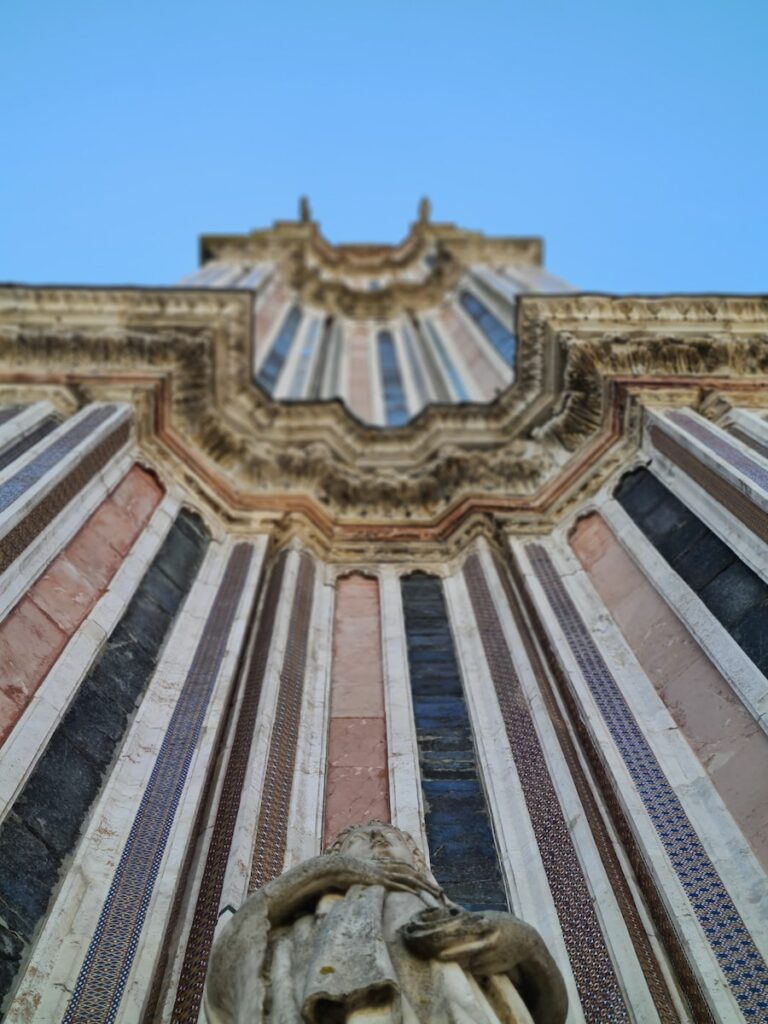
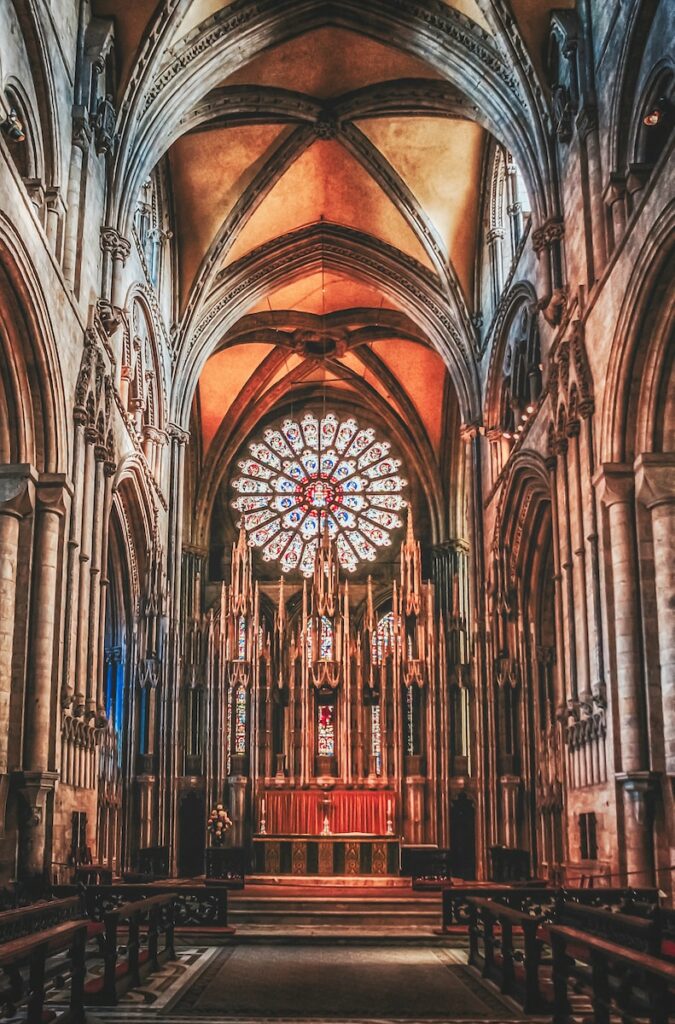
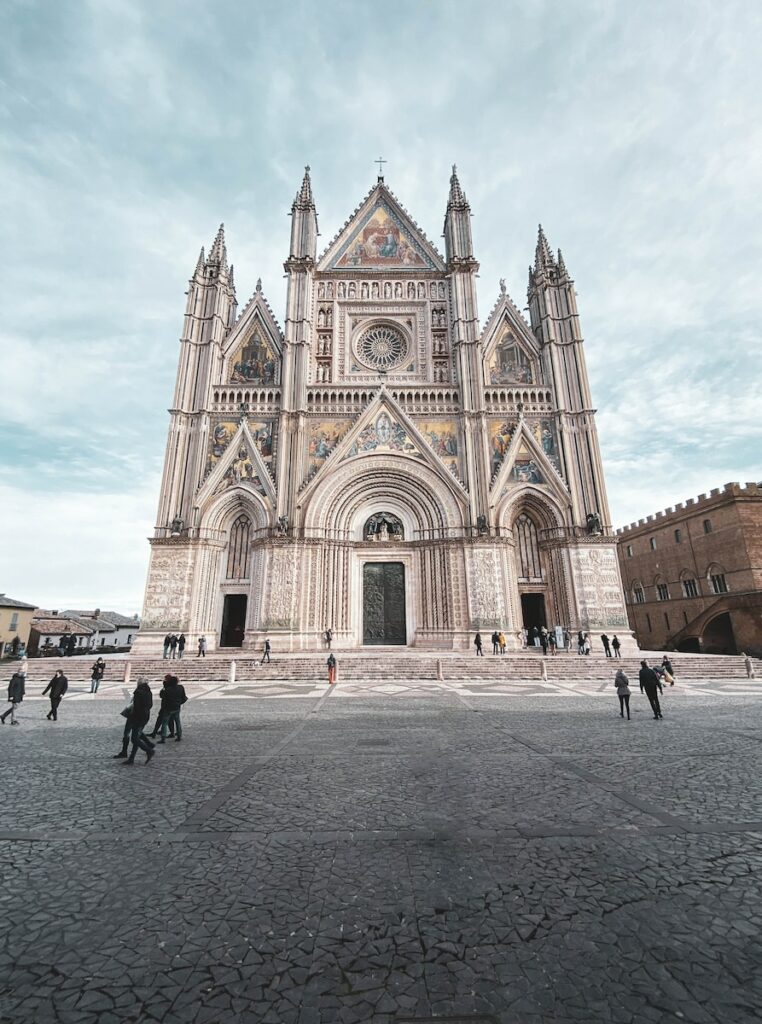
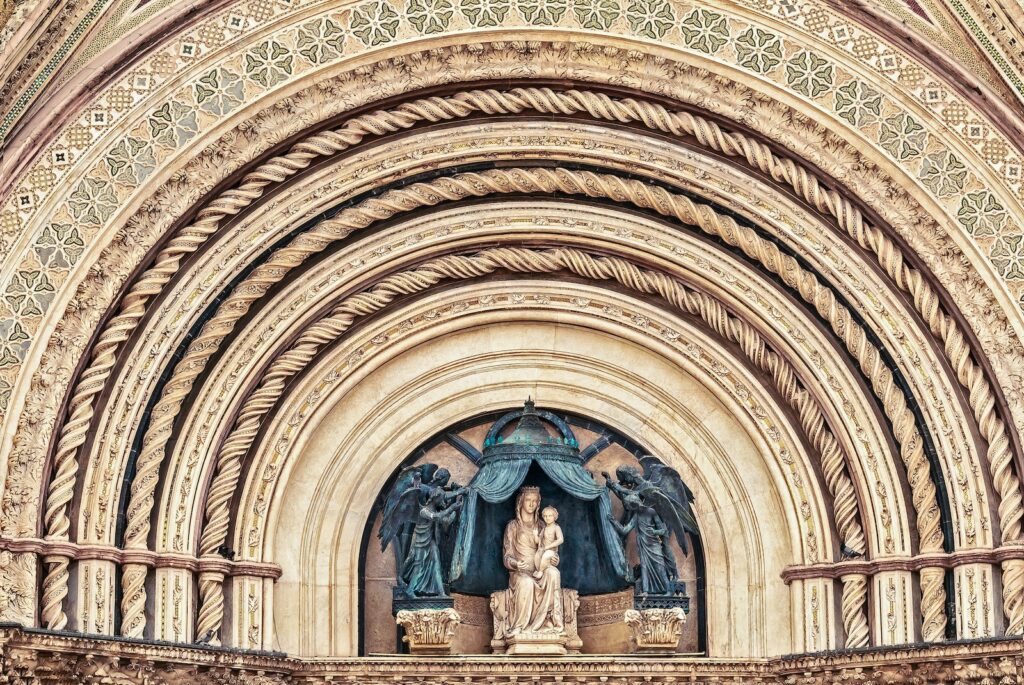
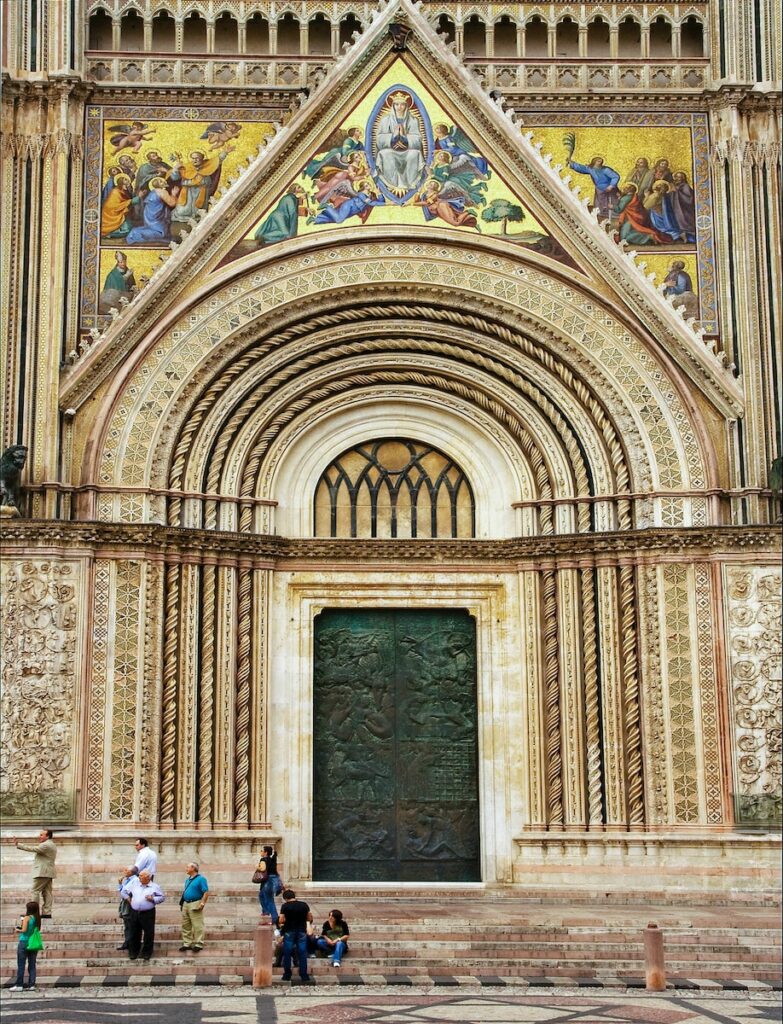
The facade of Orvieto Cathedral has undergone significant changes over the centuries, transitioning from the Romanesque style to the Gothic style. The original Romanesque facade featured simple geometric patterns and sculptural reliefs depicting biblical scenes. However, in the 14th century, the facade was redesigned in the Gothic style, characterized by pointed arches, intricate tracery, and statues of saints. This transformation reflects the shift in architectural trends and the desire to create a more elaborate and visually striking entrance to the cathedral.
Beneath Orvieto Cathedral lies a fascinating crypt, filled with hidden chambers and artifacts. This underground space was used for various purposes throughout history, including as a burial site for important religious figures and as a storage area for valuable treasures. Exploring the crypt allows visitors to discover ancient tombs, intricate frescoes, and relics from the past. It provides a unique glimpse into the history and culture of Orvieto, offering a deeper understanding of the cathedral's significance.
Orvieto Cathedral has a rich musical tradition, with choral music and organ performances playing a central role in its worship services. The cathedral's choir, composed of talented singers, performs sacred music that enhances the spiritual atmosphere of the space. Additionally, the cathedral boasts a magnificent organ, known for its powerful sound and intricate craftsmanship. Organ concerts are regularly held, allowing visitors to experience the awe-inspiring music in the grandeur of the cathedral. The musical legacy of Orvieto Cathedral continues to captivate audiences and contribute to the cultural heritage of the city.
The Orvieto Cathedral, located in the Umbria region of Italy, showcases several unique French Gothic features that distinguish it from other cathedrals of the same period. One notable feature is the use of pointed arches throughout the building, a characteristic element of French Gothic architecture. These arches create an elegant and soaring effect, drawing the eyes upward and giving the cathedral a sense of verticality.
The sculptures adorning the exterior of Orvieto Cathedral are a testament to the influence of French Gothic art. Elaborate and intricate, these sculptures depict various biblical scenes, saints, and figures from Christian mythology. The sculptures are known for their attention to detail and the skillful craftsmanship that went into their creation. They add a sense of grandeur and religious symbolism to the cathedral's facade, making it a true masterpiece of Gothic sculpture.
Flying buttresses are a defining feature of French Gothic architecture, and Orvieto Cathedral is no exception. The cathedral's design incorporates several flying buttresses that support the weight of the building's massive stone walls and allow for the inclusion of large stained glass windows. These buttresses are not only functional but also add a sense of drama and grace to the cathedral's exterior. They create a visually striking silhouette, with their arched forms reaching out and seemingly defying gravity.
The Orvieto Cathedral boasts a stunning display of French Gothic stained glass windows. These windows are characterized by their intricate designs and vibrant colors, which create a mesmerizing play of light inside the cathedral. Each window tells a unique story or depicts religious figures, adding to the overall beauty and spiritual atmosphere of the cathedral.
The bell tower of Orvieto Cathedral showcases a distinct French Gothic influence through its emphasis on verticality. The tower reaches great heights, with its slender proportions and pointed arches contributing to a sense of upward movement. This verticality is a hallmark of the French Gothic architectural style and adds to the grandeur and majesty of the cathedral's overall design.
Orvieto Cathedral incorporates symbolic iconography inspired by French Gothic themes. The intricate carvings and sculptures found throughout the cathedral depict biblical scenes, saints, and other religious symbols. These elements not only serve as decorative embellishments but also convey deeper spiritual meanings, enriching the worship experience for visitors and reinforcing the cathedral's connection to the French Gothic tradition.
In conclusion, exploring the French Gothic elements in Orvieto Cathedral reveals a marvel of architecture that highlights the importance of this style in the history of European art and culture. The cathedral's soaring pointed arches, intricate rib vaults, and delicate tracery exemplify the technical and artistic achievements of the Gothic period. The impact of these elements is evident in the cathedral's ability to create a sense of awe and transcendence, drawing visitors into a spiritual experience. Moreover, the relevance of French Gothic architecture in today's context lies in its enduring influence on contemporary architectural design and its ability to inspire awe and wonder in viewers. Orvieto Cathedral stands as a testament to the timeless beauty and significance of French Gothic architecture, reminding us of the power of human creativity and the enduring impact of architectural masterpieces.
Immerse yourself in architecture’s most boundary-pushing ideas—where innovative home improvements meet visionary urban developments. Discover new building techniques, materials, and creative concepts that are redefining how we shape our spaces on a global scale.